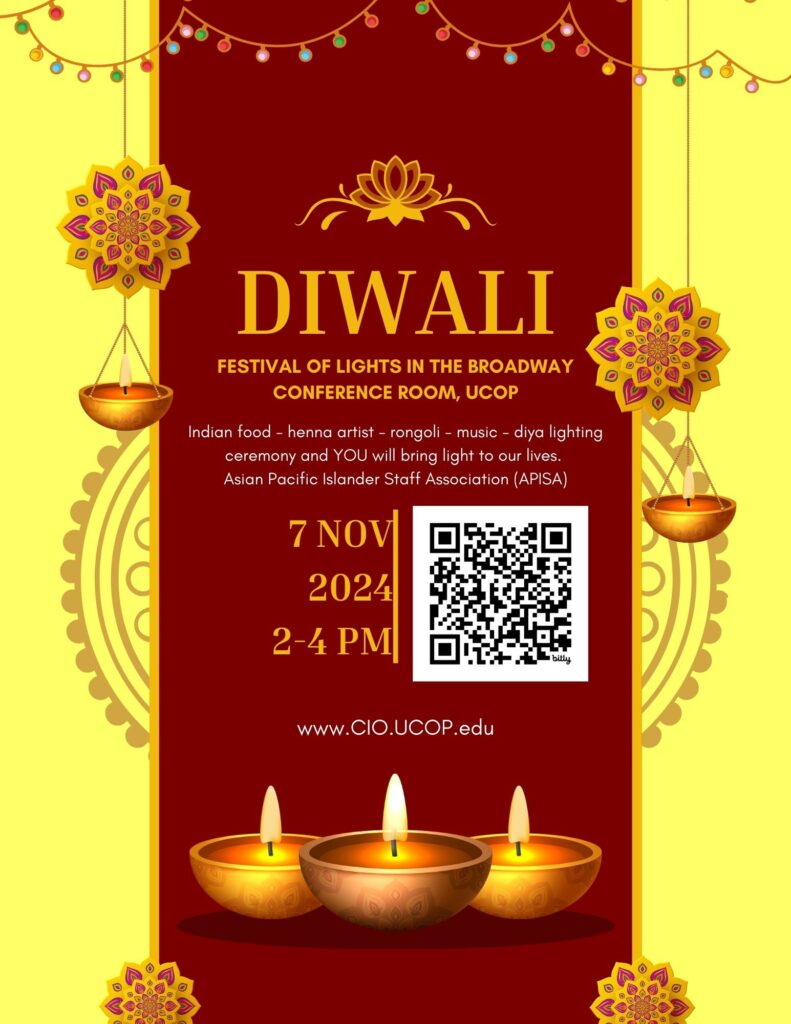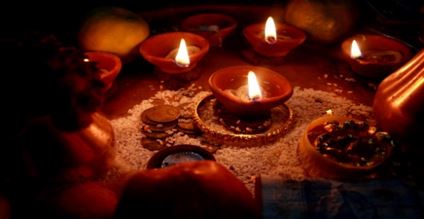Please join the Asian Pacific Islander Staff Association (APISA) at UC Office of the President in celebrating Diwali, the festival of lights, for a vibrant and joyous occasion with delicious Indian treats — both savory and sweet, music, conversation and more! Colleagues are welcome to attend in South Asian/Indian attire.
Join us
- What: APISA Diwali Celebration
- When: Tuesday, Nov. 7, 2 – 4 p.m. (PT)
- Where (in-person): Oakland, UC Office of the President Broadway Conference Center
- Where (online) Zoom (from 2 – 2:45): https://UCOP.zoom.us/j/99896234294
- Sponsor: UC Office of the President Asian Pacific Islander Staff Association (APISA)
- Contact: Sujit.Thapa@UCOP.edu, Sushant.Prasad@UCOP.edu or Laurel.Skurko@UCOP.edu
- Please RSVP here
Agenda
- 2-4 pm – Reception, with a hand-selected Indian music playlist, a henna artist, delicious Indian snacks (samosas/pakoras) and favorite sweets selected by the Diwali planning committee
- 2:40-2:45 pm – APISA welcome
- 2:45-2:50 pm – Diya lighting
- 2:50 – 4 pm – Music, food, and henna art
Planning committee
Sushant Prasad, Alex Santos, Sujit Thapa, Tony Yang, Pratima Reddy, Laurel Skurko, Shirley Bittlingmeier, Barbara Hui, Melvin Tangonan, Anisha Ashraf, Mey Saechao, Arun Duggal, Pikka Sodhi, Veeresham Merugu, Vijayalakshmi Kota, Anvita Seth Kapoor, May Saechao and Anna Chan
Background on Diwali
The name Diwali is derived from the Sanskrit word Dipawali, which means “rows of light.” Diwali is one of the major religious festivals for Hindus across the globe* and marks the victory of good over evil. Hindu families celebrate this festival by decorating their homes with candles and colorful lights and gathering with family members and friends to enjoy delicious food and time together.
This year, the Diwali celebration actually falls on November 12. Traditionally, the date falls on the darkest day of the lunar month, which is the day of the new/no moon. This occurs between October and November each year. It is a five-day festival, with the primary celebration (and new/no moon and darkest day) falling on the 3rd day in most places in South Asia. This year, this 3rd day and the new moon falls on Sunday, November 12, 2023.
Families celebrate this festival by decorating their homes with candles and colorful lights and Rangoli, colored patterns drawn on the floor or table – an art form that originates in India. They also sing and dance, as well as gather with family members and friends to enjoy delicious food and time together. Adults also enjoy card and dice games while kids light the sky with fireworks.
- The third day after Diwali begins is called Lakshmi Puja. This is considered the most auspicious day in Diwali, where the goddess of fortune and wealth, ‘Lakshmi’ is worshiped at homes to bless the home with good fortune and abundance. This year, this falls on November 12, 2023.
- On the fifth or final day, in North India and Nepal, people celebrate Bhai Dhooj/Bhai Tika (brother puja) to mark the bonding between sisters and brothers and take a moment to share blessings and gifts with each other. This year, this falls on November 14, 2023.
*Diwali is celebrated across South Asia. According to Wikipedia, South Asia includes about 90% of the world’s Hindu population, and includes the following countries: Afghanistan, Bangladesh, Bhutan, India, Maldives, Nepal, Pakistan, and Sri Lanka
Menu
- Samosas
- Pakoras
- Barfi (coconut sweets)
- Kaju Katli (cashew diamonds)
- Cardamon-almond cake
- Chai tea

Playlist during the November 7th celebration
Light background music:
- Soothing Santoor Music | The Genius Pandit Shiv Kumar Sharma | Indian Classical Instrumental Music
- Pt Shivkumar Sharma & Ustad Zakir Hussain I Raag Madhuwanti I Indian Classical HD
- Best of Pandit Hariprasad Chaurasia | Flute Music Relaxing | Indian Classical Music Instrumental
Dance/Party songs:
1. Punjabi song https://www.youtube.com/watch?v=yThYwOixjYg
2. Sauda khara https://www.youtube.com/watch?v=LYEqeUr-158
3. Jai Jai Shiv Shankar https://www.youtube.com/watch?v=oGneAab3e88
4. Thumka https://www.youtube.com/watch?v=KgpFBdapobY
5. Deewangi Deewang https://www.youtube.com/watch?v=74OyXALqv1Y
6. Say Shava Shava https://www.youtube.com/watch?v=ZTARlM0pCP4
7. Bole Chudiyan https://www.youtube.com/watch?v=IBvg3WeqP1U
8. Raavan https://www.youtube.com/watch?v=lxB-ki-qE64
9. RRR – Naacho Naacho https://www.youtube.com/watch?v=sAzlWScHTc4
10. Daler Mehndi https://www.youtube.com/watch?v=h6Ze5Hqa1wA
11. Ho Jayegi Balle Balle https://www.youtube.com/watch?v=Q_kZclGAjTk12. “Kudiyan Sehar Diyan”https://www.youtube.com/watch?v=cMELhISOv-s
About Asian Pacific Islander Staff Association (APISA) at UC Office of the President
APISA Mission Statement
APISA promotes and enhances the well-being of Asian, Asian American and Pacific Islander staff, faculty and students through active participation and representation at UC Office of the President and the community at large. APISA sponsors activities that foster inclusivity, understanding and community building about Asians, Asian Americans, and Pacific Islanders.
APISA History
APISA Started in 2013 as an affinity group and held UC Office of the President events to promote camaraderie and better understanding of Asians, Asian Americans and Pacific Islanders. As an Employee Resource Group (ERG), APISA is becoming a greater advocate for UC employees to promotes its values and goals.
APISA Contacts
- Tony Yang, vice-chair
- Sujit Thapa, vice-chair
- Barbara Hui, Treasurer
- Melvin Tangonan, Secretary

UC Office of the President
Glossary
Barfi or burfi is a milk-based sweet from the Indian subcontinent with a fudge-like consistency. Its name comes from the Persian and Urdu word (barf) for snow. Barfi is consumed throughout India and Pakistan and is especially popular in North India. It is often served at celebrations and religious festivals such as Diwali and Holi [Reference: Wikipedia]
Diya – A traditional Diya (dee·uh) is a clay oil lamp native to India. A diya is lit during celebrations such as Diwali [Reference: Diyacandleco.com]
Mehndi – Called mendhika in Sanskrit, maruthani in Tamil, mehndi in Hindi and henna from the Arabic al-hinna, the flowering shrub Lawsonia inermis has multiple uses, many of them involving hair. India’s indigenous medical traditions like ayurveda and Siddha, which differ on many points, agree that henna is good for hair [Reference – Google]
Rangoli – The ancient sand art of India
Sangeet – The Sanskrit term Sangeet refers to a genre of Indian music that includes vocal, instrumental, and musical forms that are used for dance [Reference: Different Genres Of Music And Dance Popular In India | Ben Vaughn]







